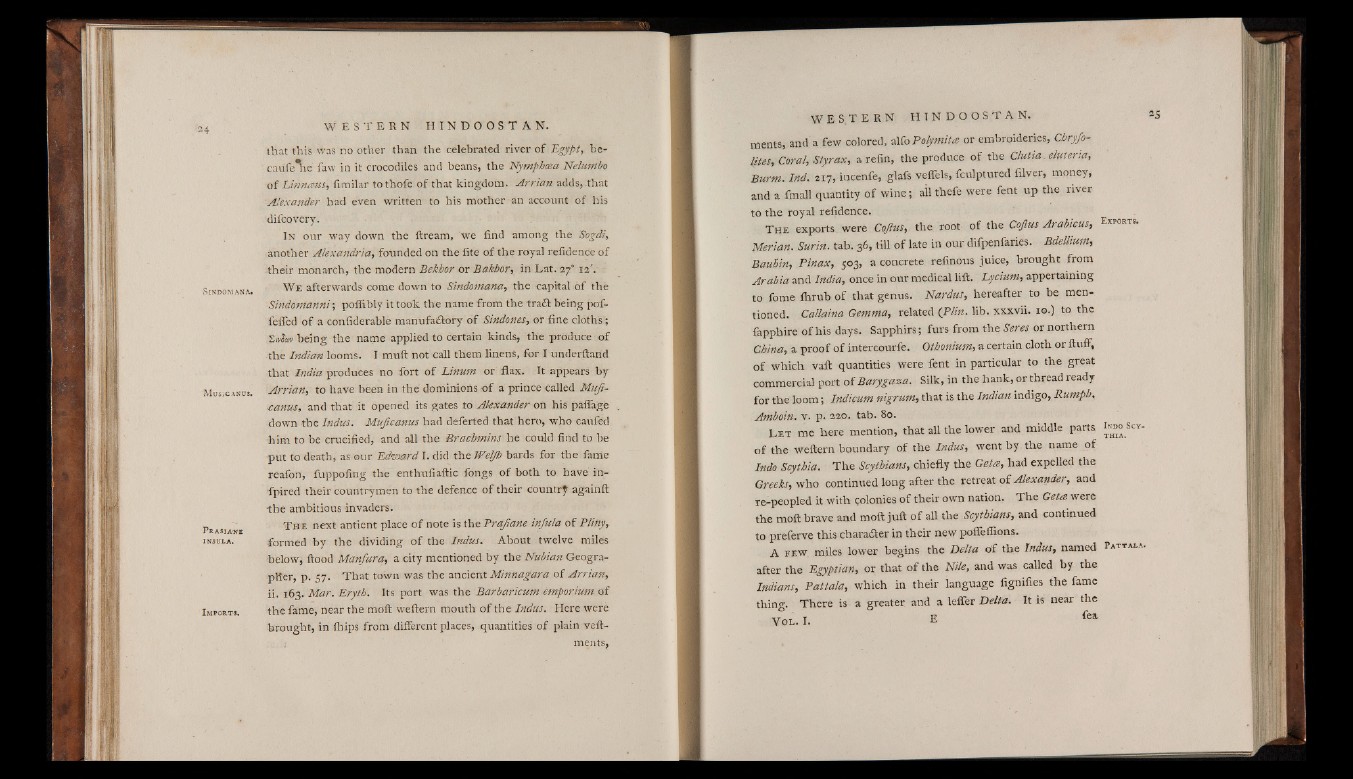
SlNDOMANA.
M U SIC ANUS.
P rasia-ne
INSULA.
I m p o r t s .
tliat this was no other than the celebrated river of Egypt, be-
caufe^ie faw in it crocodiles and beans, the Nymphoea Nelumbo
of Linnaus, fimilar tothofe of that kingdom. Arrian adds, .that
Alexander had even written to his mother -an account of his
difcovery.
In our way down the ftream, we find among the 'Sogdi,
another Alexandria, founded on the fite of the royal refidence of
their monarch, the modern Bekhor or Bakbor, in Lat. 27” 12'.
We afterwards come down to Sindomana, the capital of the
Sindomanni; poifibly it took the name from the trait being pof-
fefled of a confiderable manufa&ory o f Sindones, or fine cloths;
zAm being the name applied to certain kinds, the produce of
the Indian looms. I muft not call them linens, for I underftarid
that India produces no fort of Linutn or flax. It appears by
Arrian, to have been in the dominions o f a prince called Muß-
■canus, and that it opened its gates to Alexander on his paffage
down the Indus. Mußcanus had deferted that hero, who caufed
him to be crucified, and all the Brachmins he could find to be
put to death, as our Edward I. did the Weiß bards for the fame
reafon, fuppofing the enthufiaftic fongs of both to have in-
•fpired their countrymen to the defence of their country againft
the ambitious invaders.
T h e next antient place of note is the Prafiane infula of Pliny,
formed by the dividing o f the Indus. About twelve miles
•below, flood Manfura, a city mentioned by the Nubian Geographer,
p. 57. That town was the ancient Minnagara of Arrian,
ii. 163. Mar. Eryth. Its port was the Barbaricum emporium of
the fame, near the moft weftern mouth of the Indus. Here were
brought, in ihips from different places, quantities of plain veftments,
ments, and a few colored, alfo Polymita or embroideries, Cbryfo-
Iftes, Coral, Styrax, a refin, the produce of the Clutia. eluteria,
Burm. Ind. 217, incenfe, glafs veflfels, fculptured filver, money,
and a fmall quantity of wine; ail thefe were fent up the river
to the royal refidence.
The exports were CoJluS, the root of the Cojlus Arabicus, Exports.
Merian. Surin. tab. 36, till of late in our difpenfaries. Bdellium,
Baulin, Pinax, 503, a concrete refinous juice, brought from
Arabia and India, once in our medical lift. Lycium, appertaining
to fome fhrub o f that genus. Nardus, hereafter to be mentioned.
Callaina Gemma, related (Plin. lib. xxxvii. 10.) to the
fapphire of his days. Sapphirs; furs from the Seres or northern
China, a proof o f intercourfe. Otbonium, a certain cloth or fluff,
o f which vaft quantities were fent in particular to the great
commercial port of Barygaza. Silk, in the hank, or thread ready
for the loom; Indicum nigrum, that is the Indian indigo, Rumph.
Amboin. v. p. 220. tab. 80.
L e t me here mention, that all the lower and middle parts Scr"
of the weftern boundary of the Indus, went by the name of
Indo Scythia. The Scythians, chiefly the Getce, had expelled the
Greeks, who continued long after the retreat of Alexander, and
re-peopled it with colonies of their own nation. The Get<z were
the moft brave and moftjuft of all the Scythians, and continued
to preferve this charafter in their new poffefiions.
A few miles lower begins the Delta of the Indus, named Pat«#.*.
after the Egyptian, or that of the Nile, and was called by the
Indians, Pattala, which in their language fignifies the fame
thing. There is a greater and a lefier Delta. It is near the
V o l. I. E fea